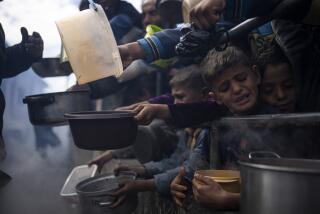Rising Tide of Sewage at Gaza Strip Poses Bigger Threat Than Palestinian Guerrillas
GAZA — The biggest threat to Israeli beaches may come not from seaborne Palestinian guerrillas but a rising tide of sewage washing up from the occupied Gaza Strip.
Whatever the fate of the 30-month-old Palestinian uprising in Israeli-occupied territories, experts say the narrow coastal strip--with an exploding population and no natural resources--is a time bomb ticking in Israel’s back yard.
Untreated sewage, festering in unpaved, overcrowded refugee camps and pouring into the Mediterranean Sea, is just one hazard in what a U.N. official called “a vicious circle of sanitary and environmental problems.”
They include tapeworms infesting many Palestinian children, and salt seeping into the area’s wells, threatening the drinking water.
“Gaza is a sewage time bomb waiting to explode,” said Joyce Starr, co-chairman of the Global Strategy Council, a U.S.-based think-tank working on world water problems.
“People rarely think of sewage as a strategic issue, but even if there is a peace agreement with Israel, Gaza has reached the limits of its disposable water resources,” she said.
Starr said Israel refuses to invest in the infrastructure of the Gaza Strip, a sandy plain 28 miles long and on average five miles wide, which the Jewish state captured from Egypt in the 1967 Middle East War.
Two U.N. agencies have plans to build a sewage system there, but they don’t have the $50 million the project would cost.
“If I may be really cynical: If something really disastrous happened, we might get the money,” said Jan Dahlman, a Swedish water expert with the U.N. Relief and Works Agency for Palestine refugees.
He said raw sewage from most of Gaza City and the giant Shati refugee camp is currently going directly into the sea.
With Scandinavian understatement, he added, “I wouldn’t recommend swimming off the Gaza coast.”
Prevailing currents carry the sewage northwards to Israel across an invisible sea border that no navy can seal, he added.
No one knows exactly how many people live in the Gaza Strip, but the density is one of the highest in the world, comparable with that of Calcutta.
Israeli occupation authorities, in a classified 1987 study completed on the eve of the uprising, estimated the population at 634,000 and forecast that it would soar to 1 million by the year 2000.
The impoverished Gaza population is largely dependent on work in Israel for subsistence.
There are few local jobs--the U.N. agency is the biggest employer with 4,500 employees--but about 60,000 Palestinians commute daily to menial jobs in the Jewish state.
Agency officials say there has been something of a baby boom during the uprising, perhaps because many families have been confined to their homes for prolonged periods under curfew.
Among Palestinians in the Gaza Strip, having many children is seen as an Islamic duty and a nationalist achievement.
A slogan often heard in the refugee camps says, “We are making the revolution in our beds.”
The few development projects in which Israel was engaged before the uprising were terminated when the revolt erupted.
A showcase rehabilitation program allowing refugees to build their own homes in government housing projects outside the camps has been frozen for 2 1/2 years.
In 10 years, about 70,000 refugees were re-housed in four neighborhoods outside the camps.
But even while the program was in operation, population growth far outstripped the rate of housing construction.
Agency officials say the Israeli program compounded the overcrowding problem because a condition of rehabilitation was that the refugees destroy their camp shelter, leaving the plot unused.
No new housing may be built in the camps, and Israel does not allow the building of a second story on refugee shelters.
In winter, cesspits overflow, flooding homes in low-lying areas of the camps. Children play knee-deep in sewage.
In summer, untreated sewage seeping into the Wadi Gaza river bed draws swarms of mosquitoes spreading disease.
“Intestinal parasites are a major problem. Among children in the camps, not less than 50% have this infestation,” said Dr. Iyad al Rayyes, a U.N. health official.
But he said health conditions have improved in the Gaza Strip. Ten years ago, gastroenteritis from contaminated food and water was the biggest cause of death. Today the main cause is chest infections.
Israeli journalists Ehud Yaari and Zeev Schiff, in a recent book on the uprising, said the government quickly shelved the 1987 report on “The Gaza District Up to the Year 2000” because its findings were too unpalatable.
“This picture is virtually one of a human time bomb ticking away at Israel’s ear, a weapon with the potential to wreak far more damage than the strictly conventional sort,” the authors wrote.
“For unless some dramatic development takes place soon, it is Israel that will have to govern, employ and create a minimal infrastructure for these swarms of people--and it can barely cope with the wretched mass of humanity in Gaza as it is.”
More to Read
Sign up for Essential California
The most important California stories and recommendations in your inbox every morning.
You may occasionally receive promotional content from the Los Angeles Times.










